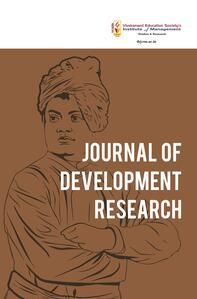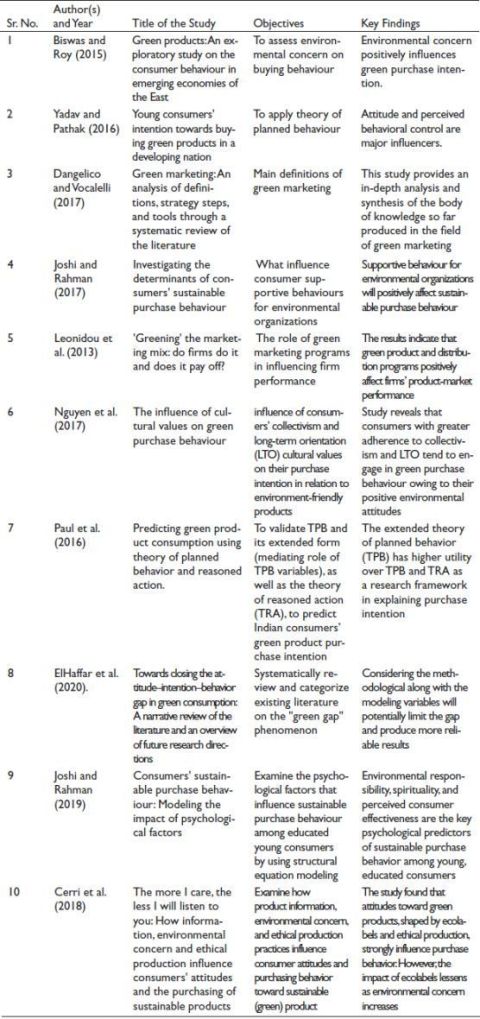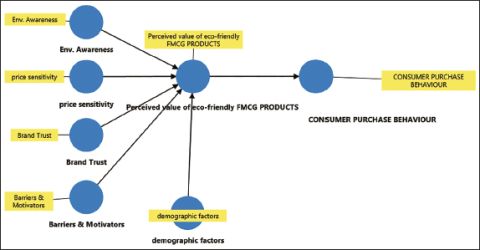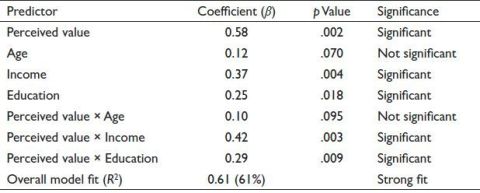
1Tilak College of Science and Commerce, Navi Mumbai, Maharashtra, India

Creative Commons Non Commercial CC BY-NC: This article is distributed under the terms of the Creative Commons Attribution-NonCommercial 4.0 License (http://www.creativecommons.org/licenses/by-nc/4.0/) which permits non-Commercial use, reproduction and distribution of the work without further permission provided the original work is attributed.
As environmental concerns grow and consumer awareness rises, there has been a notable change in purchasing habits, particularly in the fast-moving consumer goods (FMCG) sector. This empirical study seeks to explore consumer perceptions of eco-friendly FMCG products in Navi Mumbai city. A structured survey was conducted with 400 respondents from various demographics, including students, working professionals and homemakers, to evaluate their attitudes, purchasing habits and awareness regarding sustainable FMCG products. The results show that 67% of respondents are aware of eco-friendly FMCG products, but only 45% actually purchase them, which aligns with past research indicating an ‘attitude-behaviour gap’ in green consumerism. This reluctance is attributed to factors such as price sensitivity, limited availability and doubts about green claims.
Furthermore, 56% of respondents expressed a preference for eco-friendly alternatives if they were priced competitively and readily available, supporting the price-quality trade off theory. The study emphasises the importance of brand credibility, government initiatives and eco-labelling in shaping consumer behaviour. Using statistical methods like chi-square tests and regression modelling, the study reveals a significant link between environmental consciousness and purchasing behaviour. The findings offer valuable insights into consumer expectations, the challenges faced by eco-friendly brands and suggestions for businesses to improve their green marketing strategies.
Consumer perception, eco-friendly products, fast-moving consumer goods, green marketing, sustainable consumption, Navi Mumbai
Introduction
Sustainable consumption has become increasingly important in recent years, as consumers are more aware of the environmental effects of their buying choices. The fast-moving consumer goods (FMCG) sector is experiencing a shift towards eco-friendly options, motivated by concerns about plastic waste, carbon emissions and ethical sourcing practices (Joshi & Rahman, 2017). Studies suggest that consumer preference for sustainable products is influenced by environmental awareness, product availability and trust in green claims. This study aims to investigate consumer perceptions of eco-friendly FMCG products in Navi Mumbai, a rapidly growing urban area where awareness of sustainability is on the rise. Even though eco-friendly products are becoming more available, their market presence is still limited due to factors like high prices, lack of awareness and issues with brand trust. Research suggests that the gap between pro-environmental attitudes and actual purchase behaviour, commonly known as the ‘attitude-behaviour gap’, is a significant barrier to sustainable consumption (Joshi & Rahman, 2017).
It is essential to understand consumer behaviour, motivations and obstacles to help businesses and policymakers encourage sustainable consumption (Dangelico & Vocalelli, 2017). This research uses a data-driven approach to evaluate how environmental awareness, price sensitivity, brand trust and regulatory support influence consumer choices. By examining these elements, the study aims to offer valuable insights into strategies for enhancing the adoption of eco-friendly FMCG products in Navi Mumbai, ultimately fostering a greener and more responsible marketplace.
Literature Review

Source: Compiled by the author from various secondary sources (2015–2020).
Research Gap
Existing research in India has predominantly focused on descriptive studies that measure awareness levels or purchase intentions, but few have employed well-structured theoretical frameworks to understand the deeper cognitive, emotional and behavioural aspects of consumer decision-making.
Specifically, models like the Engel–Kollat–Blackwell (EKB) Model and Theory of Planned Behaviour (TPB), which have proven effective in global studies, are underutilised in Indian research settings—especially in relation to eco-friendly FMCG product consumption. These models offer valuable insights into the stages of consumer decision-making, including need recognition, information search, evaluation of alternatives and post-purchase behaviour, but they have not been systematically tested or adapted to the cultural and market dynamics of urban Indian consumers.
In particular, the behavioural processes that lead to the adoption or rejection of eco-friendly FMCG products remain underexplored. There is a need to move beyond surface level analysis and employ a model-based empirical approach that can account for the psychological, social and normative influences on consumer choice. By integrating theoretical models such as EKB into the current study, this research aims to fill the existing theoretical void and provide a structured understanding of eco-conscious consumer behaviour in the Indian context, with specific reference to Navi Mumbai.
Need of the Study
There is a growing emphasis on environmental sustainability, yet consumer adoption of eco-friendly FMCG products in India remains inconsistent, with a noticeable gap between awareness and actual purchase behaviour. Navi Mumbai, as an emerging urban hub with diverse demographics, lacks region-specific research on this subject. Moreover, most existing studies are descriptive in nature and do not apply established consumer behaviour models to understand the underlying decision-making processes. Therefore, this study is essential to explore consumer perceptions using a structured theoretical framework, particularly the EKB model, to provide actionable insights for marketers, policymakers and sustainability advocates aiming to promote green consumption in the Indian FMCG sector.
Objectives of the Study
Research Methodology
A quantitative research approach is used to systematically analyse how consumers in Navi Mumbai perceive eco-friendly FMCG products.
Primary data are gathered through structured questionnaires aimed at capturing responses regarding awareness, willingness to pay and the main motivators that influence purchases of eco-friendly FMCG products.
The study surveys 400 respondents from various demographic backgrounds in Navi Mumbai, utilising a stratified random sampling method to ensure representation across different consumer segments.
Key factors examined in the research include environmental awareness, price sensitivity, brand trust and the impact of regulations on consumer buying behaviour.
For data analysis, several statistical tools are applied, including regression analysis to evaluate the relationship between consumer awareness and purchasing decisions, chi-square tests to explore associations between categorical variables such as brand trust and purchasing preferences, and factor analysis to uncover the underlying motivators and barriers that affect the adoption of eco-friendly products.
Conceptual Model
The conceptual model visually illustrates the connections between various elements that affect consumer perception and behaviour towards eco-friendly FMCG products. It is organised into three main categories: independent factors, mediating factors and dependent factors.
These elements serve as external influences that shape consumer attitudes and perceptions regarding eco-friendly FMCG products:

These factors connect the independent variables to consumer behaviour, affecting how consumers perceive and respond to the aforementioned influences:
These factors represent the final consumer behaviours that are influenced by the previous factors:
Flow of influence independent factors (environmental awareness, price sensitivity and others).
Theoretical Framework
The EKB Model of consumer decision-making provides a structured approach to understanding how consumers process information and make purchasing decisions. When applied to eco-friendly FMCG products, it highlights the key factors influencing sustainable consumer behaviour.
Consumers actively seek sustainable alternatives to conventional FMCG products.
3.Stage 3: Alternative evaluation (comparing price, quality and trust)
Consumers weigh different options before making a purchase decision.
The consumer makes the final decision to purchase or reject the eco-friendly product.
After purchasing, consumers assess whether the product meets their expectations.
Hypothesis
The p value (.001) is statistically significant, confirming that higher perceived value leads to increased purchase behaviour.
Regression Results (Moderation Effects)

Note: R2 = 0.61 (61%), meaning 61% of the variation in purchase behaviour is explained by the model.
Data Insights
Perceived value is a significant predictor (p = .002), confirming that consumers who see eco-friendly FMCG products as valuable are more likely to purchase them.
Income and education significantly moderate the relationship (p < .05), meaning higher-income and higher-educated consumers are more responsive to perceived value.
Age is not a significant moderator (p > .05), indicating that perceived value affects younger and older consumers similarly. Since the p value for interaction effects with income and education is < .05, we reject H0 and accept H1.
Conclusion and Recommendations
This study offers a detailed insight into customer attitudes toward eco-friendly FMCG items in Navi Mumbai. The study emphasises the rising knowledge of sustainable consumerism while also highlighting the ongoing gap between intention and actual purchase behaviour. The key findings show that while 67% of respondents are aware of eco-friendly FMCG items, only 45% make real purchases. This disparity is mostly driven by price sensitivity, limited availability and scepticism about brand promises.
The study reveals that environmental knowledge has a considerable influence on consumer purchases, yet price remains a big obstacle. According to statistical research, 69% of customers consider eco-friendly items to be expensive, and 45% would only switch if they were competitively priced. Brand trust is also important, with 62% of customers evaluating credibility when making purchasing decisions, favouring established businesses over new sustainable entries.
Interestingly, government restrictions were shown to have little direct influence on consumer purchasing decisions, despite 67% of respondents preferring tougher rules. Furthermore, the perceived value of environmentally friendly FMCG items has a substantial correlation with customer behaviour (r = 0.72, p = .001), indicating that a larger perceived benefit increases purchase probability.
Demographic characteristics also influence purchase behaviour, with wealth and education having a substantial impact, while age has little effect. To overcome the ‘attitude-behaviour gap’, organisations can prioritise price tactics, increase brand trust and improve product availability, according to these findings.
Declaration of Conflicting Interests
The authors declared no potential conflicts of interest with respect to the research, authorship and/or publication of this article.
Funding
The authors received no financial support for the research, authorship and/or publication of this article.
ORCID iD
Shailu Singh  https://orcid.org/0009-0004-8044-2673
https://orcid.org/0009-0004-8044-2673
Biswas, A., & Roy, M. (2015) Green products: An exploratory study on the consumer behaviour in emerging economies of the East. Journal of Cleaner Production, 87, 463-468. https://doi.org/10.1016/j.jclepro.2014.09.075
Cerri, J., Testa, F., & Rizzi, F. (2018). The more I care, the less I will listen to you: How information, environmental concern and ethical production influence consumers’ attitudes and the purchasing of sustainable products. Journal of Cleaner Production, 175, 343–353. https://doi.org/10.1016/j.jclepro.2017.12.054
Dangelico, R. M., & Vocalelli, D. (2017). “Green Marketing”: An analysis of definitions, strategy steps, and tools through a systematic review of the literature. Journal of Cleaner Production, 165, 1263-1279. https://doi.org/10.1016/j.jclepro.2017.07.184
ElHaffar, G., Durif, F., & Dubé, L. (2020). Towards closing the attitude–intention–behavior gap in green consumption: A narrative review of the literature and an overview of future research directions. Journal of Cleaner Production, 275, 122556. https://doi.org/10.1016/j.jclepro.2020.122556
Hossain, M. S., & Roy, S. K. (2023). An integrated model of green trust and green perceived value influencing green purchase intention. Journal of Retailing and Consumer Services, 71, 103239. https://doi.org/10.1016/j.jretconser.2022.103239
Joshi, Y., & Rahman, Z. (2017). Investigating the determinants of consumers’ sustainable purchase behavior. Sustainable Production and Consumption, 10, 110–120. https://doi.org/10.1016/j.spc.2017.02.002
Joshi, Y. & Rahman, Z. (2019). Consumers’ sustainable purchase behaviour: Modeling the impact of psychological factors. Ecological Economics, 159(C), 235–243. https://doi.org/10.1016/j.ecolecon.2019.01.025
Leonidou, C. N., Katsikeas, C. S., & Morgan, N. A. (2013). ‘Greening’ the marketing mix: Do firms do it and does it pay off? Journal of the Academy of Marketing Science, 41(2), 151–170. https://doi.org/10.1007/s11747-012-0317-2
Nguyen, T. N., Lobo, A., & Greenland, S. (2017). The influence of cultural values on green purchase behaviour. Marketing Intelligence & Planning, 35(3), 377–396. https://doi.org/10.1108/MIP-08-2016-0131
Paul, J., Modi, A., & Patel, J. (2016). Predicting green product consumption using theory of planned behavior and reasoned action. Journal of Retailing and Consumer Services, 29, 123-134. https://doi.org/10.1016/j.jretconser.2015.11.006
Yadav, R., & Pathak, G. S. (2016). Young consumers’ intention towards buying green products in a developing nation: Extending the theory of planned behavior. Journal of Cleaner Production, 135, 732–739. https://doi.org/10.1016/j.jclepro.2016.06.120